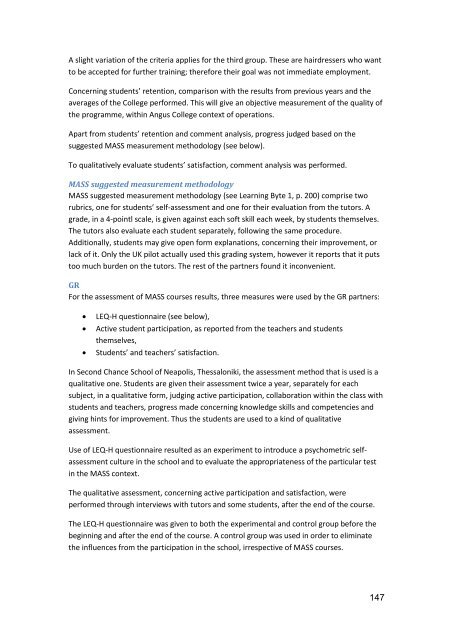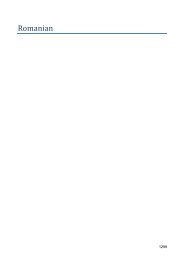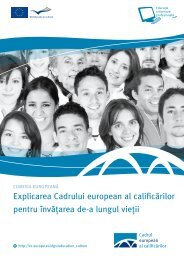Teaching and Assessing Soft Skills - MASS - Measuring and ...
Teaching and Assessing Soft Skills - MASS - Measuring and ...
Teaching and Assessing Soft Skills - MASS - Measuring and ...
Create successful ePaper yourself
Turn your PDF publications into a flip-book with our unique Google optimized e-Paper software.
A slight variation of the criteria applies for the third group. These are hairdressers who want<br />
to be accepted for further training; therefore their goal was not immediate employment.<br />
Concerning students’ retention, comparison with the results from previous years <strong>and</strong> the<br />
averages of the College performed. This will give an objective measurement of the quality of<br />
the programme, within Angus College context of operations.<br />
Apart from students’ retention <strong>and</strong> comment analysis, progress judged based on the<br />
suggested <strong>MASS</strong> measurement methodology (see below).<br />
To qualitatively evaluate students’ satisfaction, comment analysis was performed.<br />
<strong>MASS</strong> suggested measurement methodology<br />
<strong>MASS</strong> suggested measurement methodology (see Learning Byte 1, p. 200) comprise two<br />
rubrics, one for students’ self-assessment <strong>and</strong> one for their evaluation from the tutors. A<br />
grade, in a 4-pointl scale, is given against each soft skill each week, by students themselves.<br />
The tutors also evaluate each student separately, following the same procedure.<br />
Additionally, students may give open form explanations, concerning their improvement, or<br />
lack of it. Only the UK pilot actually used this grading system, however it reports that it puts<br />
too much burden on the tutors. The rest of the partners found it inconvenient.<br />
GR<br />
For the assessment of <strong>MASS</strong> courses results, three measures were used by the GR partners:<br />
LEQ-H questionnaire (see below),<br />
Active student participation, as reported from the teachers <strong>and</strong> students<br />
themselves,<br />
Students’ <strong>and</strong> teachers’ satisfaction.<br />
In Second Chance School of Neapolis, Thessaloniki, the assessment method that is used is a<br />
qualitative one. Students are given their assessment twice a year, separately for each<br />
subject, in a qualitative form, judging active participation, collaboration within the class with<br />
students <strong>and</strong> teachers, progress made concerning knowledge skills <strong>and</strong> competencies <strong>and</strong><br />
giving hints for improvement. Thus the students are used to a kind of qualitative<br />
assessment.<br />
Use of LEQ-H questionnaire resulted as an experiment to introduce a psychometric selfassessment<br />
culture in the school <strong>and</strong> to evaluate the appropriateness of the particular test<br />
in the <strong>MASS</strong> context.<br />
The qualitative assessment, concerning active participation <strong>and</strong> satisfaction, were<br />
performed through interviews with tutors <strong>and</strong> some students, after the end of the course.<br />
The LEQ-H questionnaire was given to both the experimental <strong>and</strong> control group before the<br />
beginning <strong>and</strong> after the end of the course. A control group was used in order to eliminate<br />
the influences from the participation in the school, irrespective of <strong>MASS</strong> courses.<br />
147





